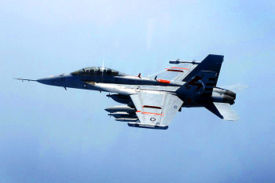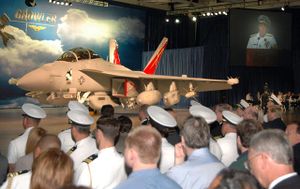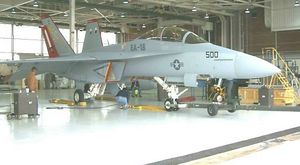PlaneSpottingWorld welcomes all new members! Please gives your ideas at the Terminal.
EA-18G Growler
| EA-18G Growler | |
|---|---|
| Type | Electronic warfare |
| Manufacturer | Boeing |
| Maiden flight | 15 August 2006 |
| Status | Flight testing |
| Primary user | United States Navy |
| Unit cost | US$66 million |
| Developed from | F/A-18F Super Hornet |
The Boeing EA-18G Growler is a carrier-based electronic warfare version of the two-seat F/A-18F Super Hornet. It is slated to begin production in 2008, with fleet deployment in 2009. The EA-18G will replace the Navy's EA-6B Prowler.
Contents
Development
An electronic attack version of the F/A-18F, the EA-18G Growler will replace the Navy's EA-6B Prowler. An F/A-18F "F-1" was re-fitted with ALQ-99 electronic-warfare system, and successfully completed an initial flight demonstration of the EA-18 Airborne Electronic Attack (AEA) concept aircraft flight on November 15, 2001.[1]
The first EA-18G test aircraft went into production in October 22, 2004.[2] The EA-18G had a public rollout on August 3, 2006.[3] The first test aircraft, known as EA-1 made its initial flight in St. Louis on August 15, 2006,[4] and ferried to the US Navy's Naval Air Station Patuxent River, Maryland on September 22, 2006. EA-1 primarily supports ground testing in the Air Combat Environment Test and Evaluation Facility (ACETEF) anechoic chamber. The second aircraft, known as EA-2 first flew on November 10, 2006,[5] and was delivered to NAS Patuxent River (Pax River) on November 29, 2006.[6] EA-2 is the primary AEA flight test aircraft, initially flying on Pax River's Atlantic Test Range (ATR) for developmental test of the AEA system before transitioning to the Electronic Combat Range (ECR, or 'Echo Range') in Naval Air Weapons Station China Lake in California.
In an April 2006 report, the United States Government Accountability Office expressed concerns that because the EA-18G was apparently "not fully following the knowledge-based approach inherent in best practices and DOD’s acquisition guidance", the program had an increasing risk of "future cost growth and schedule delays".[7] The report recommends that the DOD consider purchasing additional ICAP III upgrades for EA-6Bs to fill any current and near-term capability gaps and restructure the initial EA-18G production plans so that procurement takes place after the aircraft has "demonstrated full functionality".
The US Navy has ordered a total of 57 airplanes to replace its existing EA-6B Prowlers in service, all of which will be based at NAS Whidbey Island save for Reserve Squadron VAQ-209 based at NAF Washington, MD. Regular production is slated to begin in 2008, with Initial Operational Capability expected in 2009. The Navy is planning to buy 90 aircraft in order to equip 10 squadrons.[8]
The Growler has more than 90% in common with the standard Super Hornet, sharing airframe, AESA radar and weapon systems such as the AN/AYK-22 Stores Management System. The 20mm Vulcan cannon is removed from the nose to add additional electronics (and in other parts of the airframe as well), ALQ-218 wingtip receivers are added to the wings, also ALQ-99 high-band and low-band jammers. These jamming equipments, as well as external fuel tanks, will add increased drag, but the EA-18G will have longer-range and loiter time over target area.
EA-18Gs will carry AIM-120 AMRAAM missiles for self-defense, and two AGM-88 HARM missiles, or AGM-88E AARGM (Advanced Anti-Radiaiton Guided) missiles for destroying enemy radar sites. Boeing is looking into other potential upgrades, the AN/ALQ-99 radar jamming pod might be replaced in the future, and they’re looking into adding weapons and replacing the satellite communications receiver for the 2008 budget.
Features
The EA-18G can be fitted with up to five ALQ-99 tactical jamming pods and will typically add two AIM-120 self-defense missiles and two AGM-88 High Speed Anti-Radiation (HARM) missiles.[9] The EA-18G will also use the INCANS Interference Cancellation system that will allow voice communication while jamming enemy communications, a capability not available on the EA-6B.[10]
Specifications (EA-18G Growler)
Template:Aircraft specification
References
- ↑ "Boeing Successfully Completes Initial Flight Demonstration of EA-18 Airborne Electronic Attack Variant" Boeing Global Strike Systems, November 15, 2001
- ↑ "Boeing Begins Work on First EA-18G Test Aircraft" Boeing Global Strike Systems, October 21, 2004
- ↑ "Boeing rolls out first EA-18G Growler" Boeing Global Strike Systems, August 4, 2006
- ↑ "Boeing Flies EA-18G Growler for First Time" Boeing Global Strike Systems, August 16, 2006
- ↑ Second Boeing EA-18G Growler Takes to the Air
- ↑ Boeing Delivers Second EA-18G Growler to U.S. Navy
- ↑ "Option of Upgrading Additional EA-6Bs Could Reduce Risk in Development of EA-18G" Government Accountability Office
- ↑ EA-18G Program: The USA's Electronic Growler - EA-18G: The Program
- ↑ "Navy Awards Boeing $9.6 Billion in Super Hornet and EA-18G Contracts" Boeing Global Strike Systems, December 29, 2003
- ↑ "Boeing EA-18G Program Completes INCANS Verification Testing, Demonstration" Boeing Global Strike Systems, November 8, 2005
External links
Related content
Related development
Comparable aircraft
Designation sequence
Related lists
- List of active United States military aircraft
- List of military aircraft of the United States
- List of fighter aircraft
Lists relating to aviation | |
|---|---|
| General | Timeline of aviation · Aircraft · Aircraft manufacturers · Aircraft engines · Aircraft engine manufacturers · Airports · Airlines |
| Military | Air forces · Aircraft weapons · Missiles · Unmanned aerial vehicles (UAVs) · Experimental aircraft |
| Notable incidents and accidents | Military aviation · Airliners · General aviation · Famous aviation-related deaths |
| Records | Flight airspeed record · Flight distance record · Flight altitude record · Flight endurance record · Most produced aircraft |




